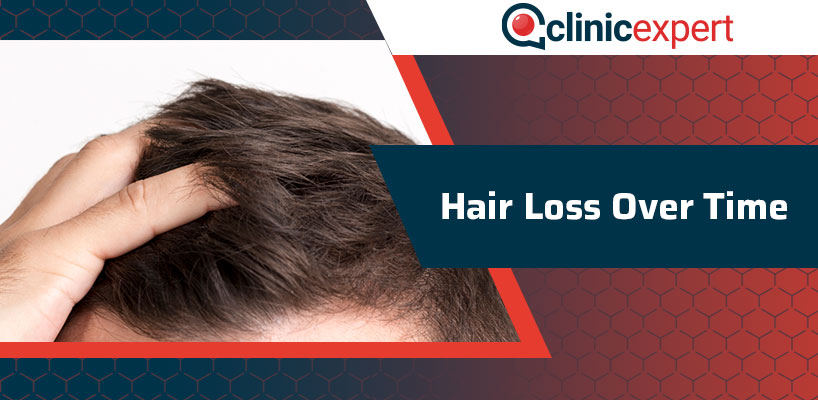Hair Loss Over Time It’s natural to lose some hair every day as part of this period. Some individuals, however, can suffer excessive (more than normal) hair loss. Hair loss of this sort can affect men, women, and children.
Aging and Hair Loss
Aging can make a lot of improvements to the whole body. Your hair is one aspect of the body that is not spared from the aging process. While the extent of hair loss due to aging is mostly dictated by genetics, virtually all people will undergo any hair loss due to aging. In the normal aging process, the hair starts to thin and to collapse. Typically, hair falling out will be replaced by new hair growth, but as we mature, it will happen less and less.
Hair Loss While Aging
It’s natural to lose around 100 hairs a day, regardless of age. Thinning hair is a common symptom of aging and does not suggest an underlying concern until the hair loss is severe. Hormonal fluctuations can affect hair growth patterns, so it is widespread for menopausal women to experience hair thinning and hair loss. The hair on the head and body can be thinner, but lowering the estrogen can create more visible hair on the upper lips or chin. Hair follicles often decrease in size with age to grow more delicate hair, resulting in differing baldness degrees, particularly in men.
Your hair passes through three stages in your life – the period of development, the process of transformation, and the process of rest. Hair expands during the development process over many years. It is planning to fall out during the shorter transformation process. It falls out during the rest of the process. As you age, each hair spends more time in the resting process, ensuring that the hair is shed faster than it grows in. Although some women suffer intermittent or mild hair loss, millions of women suffer female pattern hair loss (FPHL). FPHL is the most common cause of female hair loss, occurs typically when a woman is in her 40s, 50s, or 60s. It is gradual, but without any therapy, hair loss persists. So, the hair loss can spread to other areas of the scalp.
Methods for Hair loss
Two of the most advanced and standard hair transplant procedures will be defined: FUE (Follicular Unit Extraction) and DHI (Direct Hair Implantation) hair transplant.
What’s an FUE Hair Transplant?
FUE hair transplant surgery has achieved attention over the last decade. Compared to the classic procedure, grafts are harvested and inserted one at a time, and no strip of skin is withdrawn. As a result, FUE does not leave any noticeable scarring and guarantees natural-looking outcomes.
Procedure
During an FUE hair transplant, the surgeon manually removes each follicle one at a time and positions it in a storage solution. Upon completion of the extraction, the surgeon will open the canals for the grafts to be inserted. Grafts are separated from the solution and inserted in the receiver region using microblade and fine needles. The first signs are visible after 6 months, although you can expect maximum hair to develop about 12 months after the treatment.
Medicine Treatment
Treatments are available based on the hair loss type. If a drug causes your hair loss, your doctor will be able to recommend another drug. Recognizing and treating an infection can help to stop the loss of hair. Correcting a hormonal imbalance may prevent further hair loss. Medicines can also help to slow down or discourage the growth of widespread baldness. One drug, Minoxidil (also known as Rogaine), is available without a prescription. It’s spread to the scalp. It might be utilized for both men and women. A second drug, finasteride, is available with a prescription. It comes in pills, and it’s just for guys. It can take up to 6 months before you can say whether one of these medications works.
Hair Tips and Solutions
- Relieve stress: Increased stress hormones can induce added hair loss and average hair loss as we age. Lower the stress level by engaging in stress-reducing practices such as yoga or breathing exercises. It’s still a smart thing to make sure you have a full night’s rest where possible.
- Training: Engaging in activity will improve airflow and help your scalp to ‘look’ younger by stimulating hair follicles to promote growth. Aging can make your bones weak, and your muscles deteriorate, so keeping up with your workout schedule, even though it’s a light workout, can help keep your whole body safe as you age. Gentle fitness exercises like yoga and cycling are secure options.
- Eating Well: Eating a well-balanced diet with lots of protein will help give your body the energy required to develop healthy hair cells and promote development. A diet containing a healthy level of Omega-3 fatty acids, vitamins A, E, and C, and calcium will also help keep the hair healthy.
- Use Heated Styling Equipment Sparingly: Use heated styling tools such as flat irons and curling irons less frequently. When you need to use them, make sure they are set to the lowest heat setting and reduce touch times with your hair to prevent damaging delicate fabrics. Gray hair appears to be more brittle and dry than hair, with both its natural pigment and heat styling damage can turn it wiry and rugged.
- Medical assistance: Minoxidil is available in the brand and the generic version in liquid or foam. It has been used for a long time to treat male pattern hair loss. The FDA now approves products containing either 2% or 5% minoxidil to treat FPHL.
- Air Dry: Avoid blow-drying wherever possible, allowing your hair to dry naturally.
- Vitamins: A biotin supplement of 3,000 mg per day is especially beneficial if you have a deficit.
If you have any questions about the procedure, you can contact us to get more information. Hair Loss Over Time



